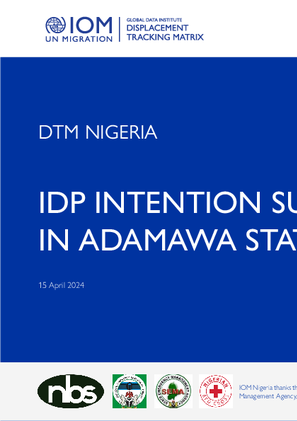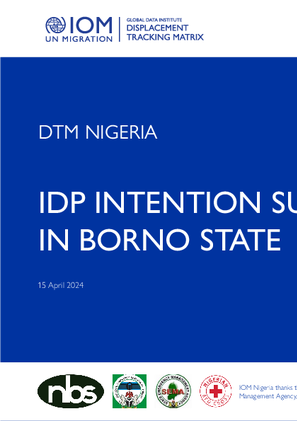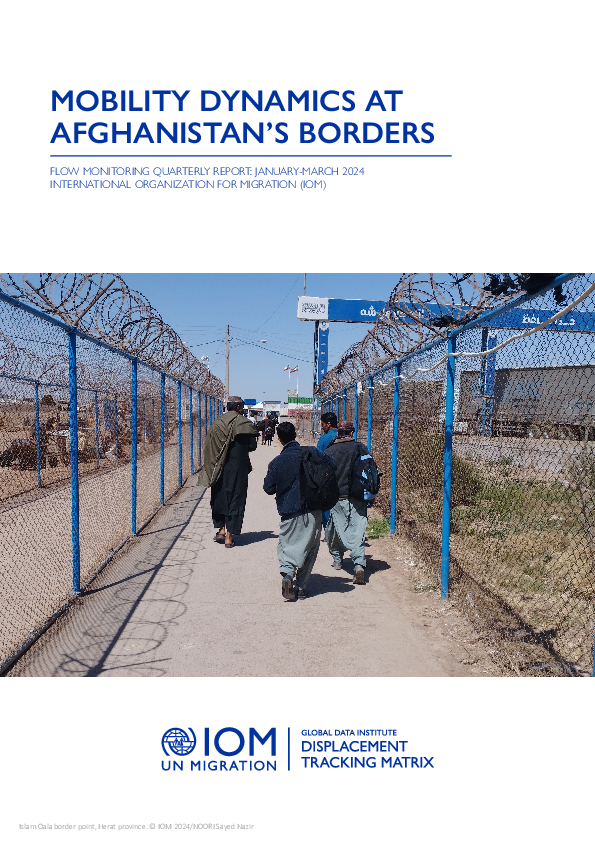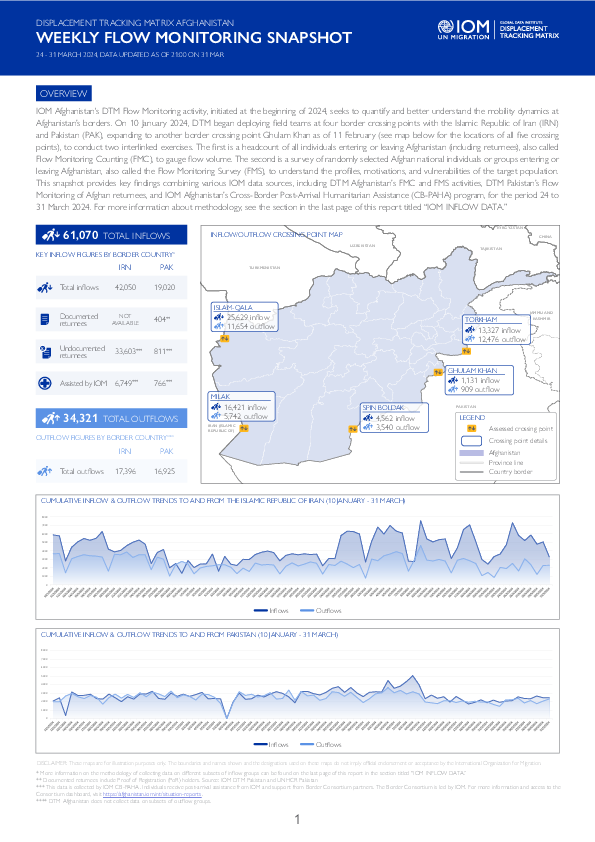-
Countries
-
Data and Analysis
-
Special Focus
-
Crisis Responses
Compilation/Overview
Color
white

Contact
DTM Nigeria, iomnigeriadtm@iom.int
Language
English
Location
Nigeria
Period Covered
Nov 16 2023
Dec 18 2023
Activity
- Survey
- Displacement Solutions
- Return Intention
While many of the IDPs continued to be displaced for prolonged periods, there is a noticeable trend of increasing numbers of IDPs returning to their places of origin, as evidenced by Round 45 of DTM assessments (June 2023) identified 2,075,257 returnees in the region. Recognizing the growing number of returnees, the IOM Displacement Tracking Matrix (DTM), in collaboration with the Camp Coordination and Camp Management (CCCM) and Protection sectors, including the National Emergency Management Agency (NEMA), National Bureau of Statistics (NBS), State Emergency Management Agency (SEMA), Nigeria Red Cross Society (NRCS), and other key partners deemed it necessary to assess the future intentions (within the next 12 months) of individuals in displacement areas to provide appropriate solution interventions. The DTM of the IOM Nigeria Mission, with the support of the partners, led the Intention Survey (IS) in Adamawa State (including the other five states of the north-east) to assess IDPs who wish to return to their place of origin, locally integrate at their current location of displacement or relocate to another part of the state (LGA), within or outside the country.

Contact
DTM Nigeria, iomnigeriadtm@iom.int
Language
English
Location
Nigeria
Period Covered
Nov 16 2023
Dec 18 2023
Activity
- Survey
- Return Intention
While many of the IDPs continued to be displaced for prolonged periods, there is a noticeable trend of increasing numbers of IDPs returning to their places of origin, as evidenced by Round 45 of DTM assessments (Sep 2023) identified 2,075,257 returnees in the region. Recognizing the growing number of returnees, the IOM Displacement Tracking Matrix (DTM), in collaboration with the Camp Coordination and Camp Management (CCCM) and Protection sectors, including the National Emergency Management Agency (NEMA), National Bureau of Statistics (NBS), State Emergency Management Agency (SEMA), the Nigerian Red Cross Society (NRCS), and other key partners deemed it necessary to assess the future intentions (within the next 12 months) of individuals in displacement areas to provide appropriate solution interventions. The DTM of the IOM Nigeria Mission, with the support of the partners, led the Intention Survey (IS) in Borno State (including the other five states of the north-east) through the BHA and ECHO fund. The aim of the IS was to assess IDPs who wish to return to their place of origin, locally integrate at their current location of displacement or relocate to another part of the state (LGA) or within the country.

Contact
DTMAfghanistan@iom.int
Language
English
Location
Afghanistan
Period Covered
Jan 10 2024
Mar 31 2024
Activity
- Survey
- Flow Monitoring Survey
- Flow Monitoring
Over the course of decades marked by conflict, Afghanistan has experienced significant movement across its borders with neighboring countries the Islamic Republic of Iran and Pakistan. This movement, influenced by linguistic, geographical, and economic factors, has played a crucial role in shaping regional dynamics and fostering cultural ties between these countries. With 4.5 million Afghan nationals currently living in the Islamic Republic of Iran and 3.2 million currently living in Pakistan1, Afghan nationals not only seek economic opportunities, international protection and safety in these countries, but often visit family or participate in short-term travel for health and other reasons. In late 2023, policies and statements by officials in both the Islamic Republic of Iran and Pakistan called for the expulsion of undocumented foreigners, the majority of whom are Afghan nationals. Developments such as these recent policies targeting Afghan migrants have impacted movements to Afghanistan, as seen late last year when returns from Pakistan increased following the announcement of the “Illegal Foreigners’ Repatriation Plan (IFRP),” setting a deadline for unregistered or undocumented foreigners to voluntarily return to their countries or face deportation.
In response to these recent movements, IOM Afghanistan re-launched its DTM Flow Monitoring (FM) activity at the beginning of 2024 to provide critical insights into current mobility dynamics at Afghanistan’s borders. Flow Monitoring is designed to track the scale and characteristics of human mobility along the borders, including volume, intended destinations, reasons for movement, and intended lengths of stay. From January to the end of March 2024, DTM counted 567,411 individuals entering Afghanistan, 406,919 leaving Afghanistan, and interviewed 49,441 regarding their reasons for movement and intentions. The following report provides findings from DTM’s Flow Monitoring exercises for the first three months of data collection, examining trends and profiles among inflow and outflow groups to inform better targeted response mechanisms.
The report is structured in four sections. The first section, “Cumulative Flow Trends,” gives an overview of the total inflow and outflow numbers and trends between January and March. This section is linked to DTM’s Flow Monitoring Counting exercise (see details in “Methodology and Limitations”). The second and third sections, “Mobility Dynamics: The Islamic Republic of Iran” and “Mobility Dynamics: Pakistan” explore findings from interviews with people leaving and entering Afghanistan via borders with the Islamic Republic of Iran and with Pakistan, respectively. These sections are followed by “Mobility Dynamics: Conclusions” which summarizes and analyzes the findings from the interviews. These last three sections are linked to DTM’s Flow Monitoring Surveys exercise (see details in “Methodology and Limitations”).

Contact
dtmukraine@iom.int
Language
English
Location
Ukraine
Snapshot Date
Mar 01 2024
Activity
- Survey
Revisions to the eligibility criteria that came into effect in March 2024 limited access to the IDP living allowance based upon a specific set of socio-economic vulnerability profiles. This introduction of additional criteria is intended to ensure that social assistance in Ukraine is capable of supporting the most vulnerable, both among those who have been displaced and the general population. However, this increases the risk of excluding some vulnerable individuals who may lose access to the IDP living allowance under the new criteria. This reduction in monthly household income could impact on the ability of vulnerable households to meet their basic needs and rebuild their lives.
The purpose of this brief is to provide an overview of the estimated share and number of IDPs that may still be eligible for the IDP allowance under the new policy. Using available secondary data, this thematic brief aims to provide an indicative overview of the share and number of IDPs that will not be eligible anymore, despite being vulnerable to a reduction in household income that could affect their ability to meet basic needs. The brief intends to inform and support advocacy and programming of humanitarian partners in complementarity with the new IDP allowance scheme.
Note: This brief was revised on 26 April 2024 to reflect the latest amendments to the Resolution 332 that came into effect on 22 March. The estimated impact now reflects the most up-to-date criteria for eligibility under the IDP Living Allowance.

Contact
DTM Ethiopia, DTMEthiopia@iom.int
Language
English
Location
Ethiopia
Period Covered
Feb 01 2024
Feb 29 2024
Activity
- Flow Monitoring
In February 2024, a total of 36,277 movements were observed across the six flow monitoring points (FMPs) in Ethiopia. This represents a 4.2% decrease in daily average movements in comparison with January 2024 when an average of 1,305 movements per day were observed.
The ratio between outgoing movements (63%) during February and incoming movements (37%) remained the same as the previous month. A total of 22,762 outgoing movements were observed, out of which 10,954 (48.1%) were heading to Saudi Arabia, 4,689 (20.6%) were going to Kenya, 2,029 (8.9%) to Djibouti, 1,367 (6%) to Somalia, 1,105 (4.9%) to South Africa, 859 (3.8%) to Yemen, and 668 (2.9%) to Sudan, while remaining movements were heading to other Southern African, Middle Eastern, North American and European countries.
At the same time, 13,515 incoming movements were observed, out of which 8,763 (64.9%) originated from Sudan, while 2,276 (16.8%) came from Kenya, 1,393 (10.3%) from Djibouti, 790 (5.8%) from Somalia and 293 (2.2%) came from other Middle Eastern and African countries. Most incoming movements were by Ethiopians (67.1%), followed by Sudanese nationals (31.4%). Returning Ethiopians departed from Sudan (48%), Kenya (25%), Djibouti (15.1%), Somalia (8.7%), Yemen (2%), Saudi Arabia (1.1%) and Tanzania (0.1%).

Contact
iomtashkent@iom.int
Language
English
Location
Uzbekistan
Period Covered
Oct 01 2023
Dec 31 2023
Activity
- Flow Monitoring Survey
- Mobility Tracking
This current report presents the latest available data on recent trends concerning migration issues in Uzbekistan, drawing upon data available for October-December 2023 and bringing major findings for the whole previous year from national and international datasets that are available to the public. The report includes recent major global and regional events that significantly impacted the migration situation in the country. The continuing impacts of the Russian invasion of Ukraine on traditional migration corridors in the region, changing labour migration flows, increase of climate change and migration concerns, the growing urbanization process, the social-economic circumstances, increased irregular migration trends and other major events are described as main contributing factors of the human mobility and migratory movements in the given period in the country. The report also gives insights into capacity-building sessions on migration data, which were provided by IOM in Uzbekistan in the given period and introduces major improvements in this direction.
DTM Europe gathers, validates and disseminates information on migrants and refugees travelling through the Mediterranean, Western African Atlantic, and Western Balkan routes to Europe. Key routes include:
- Eastern Mediterranean route (EMR): Bulgaria, Cyprus and Greece
- Central Mediterranean route (CMR): Italy and Malta
- Western Mediterranean route (WMR): Peninsular Coasts of Spain, Balearic Islands, Ceuta and Melilla
- Western African Atlantic route (WAAR): Canary Islands of Spain
DTM also monitors data on migrants in transit through the Western Balkans (WB) region (Albania, Bosnia and Herzegovina, Croatia, Montenegro, North Macedonia, Serbia, Slovenia, Romania, and Kosovo*). These are considered separately to prevent to the extent possible the double counting of the same persons that cross multiple borders to reach Europe.
This report presents the latest available data and trends, focusing on 2023:
- Mixed Migration Flows to Europe
- Migrant Flows Monitoring in the Republic of Türkiye
- First Arrival countries (Italy, Greece, Spain) and other countries of first arrival (Bulgaria, Cyprus and Malta)
- Transits through the Western Balkan region
- Migrants' presence, in Europe and the Republic of Türkiye

Contact
DTMAfghanistan@iom.int
Language
English
Location
Afghanistan
Period Covered
Mar 24 2024
Mar 31 2024
Activity
- Survey
- Flow Monitoring Survey
- Flow Monitoring
IOM Afghanistan's DTM Flow Monitoring activity, initiated at the beginning of 2024, seeks to quantify and better understand the mobility dynamics at Afghanistan’s borders. On 10 January 2024, DTM began deploying field teams at four border crossing points with the Islamic Republic of Iran (IRN) and Pakistan (PAK), expanding to another border crossing point Ghulam Khan as of 11 February (see map below for the locations of all five crossing points), to conduct two interlinked exercises. The first is a headcount of all individuals entering or leaving Afghanistan (including returnees), also called Flow Monitoring Counting (FMC), to gauge flow volume. The second is a survey of randomly selected Afghan national individuals or groups entering or leaving Afghanistan, also called the Flow Monitoring Survey (FMS), to understand the profiles, motivations, and vulnerabilities of the target population. This snapshot provides key findings combining various IOM data sources, including DTM Afghanistan’s FMC and FMS activities, DTM Pakistan’s Flow Monitoring of Afghan returnees, and IOM Afghanistan’s Cross-Border Post-Arrival Humanitarian Assistance (CB-PAHA) program, for the period 24 to 31 March 2024. For more information about methodology, see the section in the last page of this report titled “IOM INFLOW DATA.”

Contact
DTMAfghanistan@iom.int
Language
English
Location
Afghanistan
Period Covered
Mar 17 2024
Mar 23 2024
Activity
- Survey
- Flow Monitoring Survey
- Flow Monitoring
IOM Afghanistan's DTM Flow Monitoring activity, initiated at the beginning of 2024, seeks to quantify and better understand the mobility dynamics at Afghanistan’s borders. On 10 January 2024, DTM began deploying field teams at four border crossing points with the Islamic Republic of Iran (IRN) and Pakistan (PAK), expanding to another border crossing point Ghulam Khan as of 11 February (see map below for the locations of all five crossing points), to conduct two interlinked exercises. The first is a headcount of all individuals entering or leaving Afghanistan (including returnees), also called Flow Monitoring Counting (FMC), to gauge flow volume. The second is a survey of randomly selected Afghan national individuals or groups entering or leaving Afghanistan, also called the Flow Monitoring Survey (FMS), to understand the profiles, motivations, and vulnerabilities of the target population. This snapshot provides key findings combining various IOM data sources, including DTM Afghanistan’s FMC and FMS activities, DTM Pakistan’s Flow Monitoring of Afghan returnees, and IOM Afghanistan’s Cross-Border Post-Arrival Humanitarian Assistance (CB-PAHA) program, for the period 17 to 23 March 2024. For more information about methodology, see the section in the last page of this report titled “IOM INFLOW DATA.”

Contact
DTM Papua New Guinea, iompngmdac@iom.int
Language
English
Location
Papua New Guinea
Period Covered
Mar 01 2024
Mar 20 2024
Activity
- Mobility Tracking
- Baseline Assessment
Enga province in Papua New Guinea continues to grapple with heightened tensions stemming from recurring tribal conflicts. These conflicts have led to extensive damage to various essential infrastructure, including shelters, schools, churches, and healthcare facilities, particularly in the Middle Lai area of the Wapenamanda district. Reports indicate significant casualties and mass displacement of populations due to the ongoing fighting. Security forces, comprising both police and military personnel, are actively engaged in monitoring the situation and conducting awareness campaigns within local communities to mitigate tensions and prevent further violence.
Efforts are being made to prioritize civilian safety and prevent the escalation of hostilities. Tribal conflicts often arise from issues such as land disputes, competition over resources, and inter-clan rivalries. The data collected from 25 wards across three Local Level Government (LLGs) in the Wapenamanda and Wabag districts of Enga Province provides insight into the demographic impact of the recent conflict. Wapenamanda district emerged as the most affected area, hosting the largest number of IDPs with 2,718 individuals from 546 households displaced by the recent conflict. This represents approximately 50% of the total displaced population. Wabag Rural follows closely, accommodating 40% of the IDPs, totalling 2,186 individuals from 436 households. Wabag Urban also experiences displacement, with 549 individuals from 108 households seeking refuge.
Pagination
- Previous page
- Page 10
- Next page
